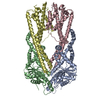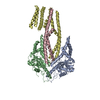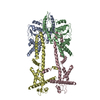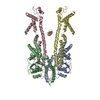+Search query
-Structure paper
| Title | The GET insertase exhibits conformational plasticity and induces membrane thinning. |
|---|---|
| Journal, issue, pages | Nat Commun, Vol. 14, Issue 1, Page 7355, Year 2023 |
| Publish date | Nov 14, 2023 |
 Authors Authors | Melanie A McDowell / Michael Heimes / Giray Enkavi / Ákos Farkas / Daniel Saar / Klemens Wild / Blanche Schwappach / Ilpo Vattulainen / Irmgard Sinning /   |
| PubMed Abstract | The eukaryotic guided entry of tail-anchored proteins (GET) pathway mediates the biogenesis of tail-anchored (TA) membrane proteins at the endoplasmic reticulum. In the cytosol, the Get3 chaperone ...The eukaryotic guided entry of tail-anchored proteins (GET) pathway mediates the biogenesis of tail-anchored (TA) membrane proteins at the endoplasmic reticulum. In the cytosol, the Get3 chaperone captures the TA protein substrate and delivers it to the Get1/Get2 membrane protein complex (GET insertase), which then inserts the substrate via a membrane-embedded hydrophilic groove. Here, we present structures, atomistic simulations and functional data of human and Chaetomium thermophilum Get1/Get2/Get3. The core fold of the GET insertase is conserved throughout eukaryotes, whilst thinning of the lipid bilayer occurs in the vicinity of the hydrophilic groove to presumably lower the energetic barrier of membrane insertion. We show that the gating interaction between Get2 helix α3' and Get3 drives conformational changes in both Get3 and the Get1/Get2 membrane heterotetramer. Thus, we provide a framework to understand the conformational plasticity of the GET insertase and how it remodels its membrane environment to promote substrate insertion. |
 External links External links |  Nat Commun / Nat Commun /  PubMed:37963916 / PubMed:37963916 /  PubMed Central PubMed Central |
| Methods | EM (single particle) / X-ray diffraction |
| Resolution | 2.8 - 5.0 Å |
| Structure data | EMDB-16801, PDB-8cr1: EMDB-16802, PDB-8cr2: EMDB-16817, PDB-8odu: EMDB-16819, PDB-8odv:  PDB-8cqz: |
| Chemicals |  ChemComp-ZN: |
| Source |
|
 Keywords Keywords |  PROTEIN TRANSPORT / PROTEIN TRANSPORT /  membrane protein insertion / GET pathway / tail anchored membrane protein / membrane protein insertion / GET pathway / tail anchored membrane protein /  MEMBRANE PROTEIN MEMBRANE PROTEIN |
 Movie
Movie Controller
Controller Structure viewers
Structure viewers About Yorodumi Papers
About Yorodumi Papers













